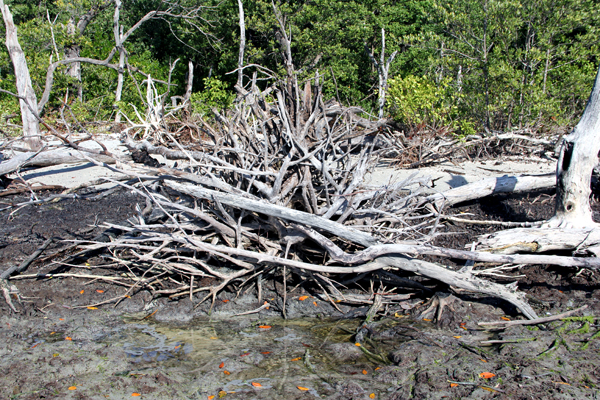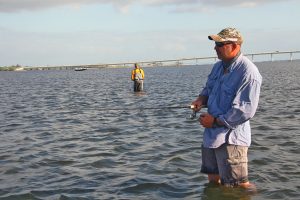February 06, 2012
By Jan Stephen Maizler
One way of reading nature's book.

Low tide at this West Coast pass exposes ideal snook fishing structure. Come back here when the tide floods.
Flats fishermen are by nature hunters. That's why they pick a form of angling where searching and hunting are core parts of the game plan. One way to improve angling results in shallow water is to put down the rod for a bit and study the characteristics-composition, layout, and currents-of the flats you like to fish. And by far the best way to really study a flat is to get down there in the water on low tide.
You'll be most effective doing this when spring low tides-the lowest lows of each month, around the new and full moons-occur at midday. The overhead sun provides the best lighting for visibility and the extreme lows of the spring tide will bring up more bottom features for discovery. Keep an eye out for winds that will help things along-a strong northeast wind will make the low tides far lower than normal on the west coast, while a strong northwester will push water out along the east coast, so try to go on one of these days if possible. (Of course, you have to take the exceptionally low water into account when you run your boat over areas that will float it easily on a "normal" low tide.)
The first step (pun intended) is to determine whether the bottom will support your weight. "Walking the walk" will give you the best results. Ideal flats for low tide striding are the hard sand, shell or rocky flats associated with ocean shorelines and some flats fronting on large open bays. On many smaller bays or backcountry flats, the bottom is marl or mud, and is too soft for wading. Here, low tide explorations may be limited to poling your skiff as far into the flat as possible (without grounding) and then scanning the features.

Shuffle your feet as you wade, even in the shallowest water. The shuffling will flush buried critters like stingrays or crabs. Stepping on one of these spiky creatures can cut short your exploration. A glide to your stride will keep you out of harm's way-usually.
Footwear is important. By far the best are dedicated wading shoes, usually made of neoprene, with hard rubber bottoms and Velcro closures or corrosion-proof zippers. These are ankle high or higher, and they keep out sand and weeds, and also prevent your feet from being nicked by shells. Some are very expensive, but if you shop carefully at the mail-order discount stores, you can find them for around $30, and with minimal care, a pair may last for years. Sandals are no good as wading shoes because they let in all the stuff you want to keep out, and also tend to get stuck in the mud. In a pinch, high-top tennis shoes are OK, but soft-soled diving boots are not-they get chopped up on oysters. Wear a hat and polarized glasses with side screens to help your vision, too.
As you wade along, the soles of your feet will come to the aid of your eyes. Although you may be wading in what looks like a uniform 10 inches of water, your "foot sonar" could pick up a subtle drop or depression in the bottom. This could be an important detail your eyes may have missed. If the drop continues, it might turn into a channel that runs across the flat. This could be a fish highway that bonefish or redfish use to access the flat in the rising waters of a new incoming tide. It could also serve as a low-water escape route. And your feet may also help you note when the bottom changes from firm sand to softer, darker mud-spots where reds might go to warm up on a chilly winter day, if you get lucky. Or you might notice a little oyster bar that's usually completely underwater.
For these reasons, you want to make a mental note of what you find on your low-tide explorations. Better yet, carry a waterproof pen and small pad in a plastic sandwich bag in your shirt pocket. You can then make a map of the small channels, grass and mud patches and other important features right on the spot. You now have a record you can refer to time and again. It will help you to understand why flats fish take the paths they do.
It is also important to note that the paths that fish are forced to take on the lowest tides may evolve into their preferred path during the higher tidal periods. On the outside of Long Key Point, south of Islamorada, the low tide highlights certain sandy "runs" not far from the shoreline. These spots are a few feet deep at low tide, and the tarpon and permit can squeeze through this edge. On the high tide, although the water is several feet deeper, the fish will continue to travel over these same spots, even though the water depth would allow them to swim far inside. A low-tide discovery like this will help you in revealing that flats fish consider bottom features in their movements, not just depth.
Potholes are always worth checking out and recording. Generally, the shapes of these depressions are vaguely circular, and have a different color than the surrounding bottom. Potholes are important to you because they frequently serve as low-tide holding areas for flats fish. The fish know instinctively that they can wait out the low tide in these holes rather than drop off the flats into an adjacent channel. As the tide floods in, flats fish may use a pothole as a feeding station. They'll often lie in wait for any forage fish to wander into the hole, then rush out of the grass along the edge or the deepest part of the hole to pounce on their prey. The potholes you discover on low tide may provide extraordinary fishing at any tidal phase.
Extreme low tides also reveal fish-attracting structure not always obvious on the higher tides. Snook that fan out over the grassflats often hold near submerged trees, wrecks and rubble. The structure eases the force of the current they must cope with. In addition, it gives them a place to hide and pounce on any unsuspecting forage fish-and something they can put between themselves and any porpoise that comes riding in on a high tide.
Low tides also reveal some of the best structure on the west coast and in the Panhandle, the oyster bar. This living structure is often home to sheepshead, redfish, mangrove snapper, jewfish and many other species. Again, the best way for you to learn the oyster bars and adjacent flats is to explore them on the lowest tides. If you attempt wading along these bars, absolute caution is a must. Wear your most protective footwear and step as carefully as you can. Oyster bars can be razor sharp. You should fish the oyster bars as fish-attracting structure much like anglers in the Keys fish the patch reefs. As the water rises, redfish may root for crabs along the bars. Trout and snook may hold near the bars, using them as structure. Often, there's a deep cut around the tips of bars that sit across the tide, and these usually produce fish when the tide is moving through them.
Also, be on constant alert for "fertile flat" signs as you wade. The presence of scurrying crabs, worms or worm and crab holes, egg casings, mullet, minnows and other signs of forage indicate that gamefish will likely prowl this area as the water rises. You'll also want to note the presence of other flats feeders such as small sharks, barracuda, stingrays, needlefish and puffers-where these guys show up, snook, reds and other species are likely at some point in the tide.
Although your low-tide striding only starts with exploration, don't be surprised if you spot a tailing redfish or bonefish now and then. These fish will be in water far too shallow for boating anglers to get at, and just might be in an eating mood. Make a careful presentation and you might find that your scouting expedition pays off quicker than you had hoped.
FS
